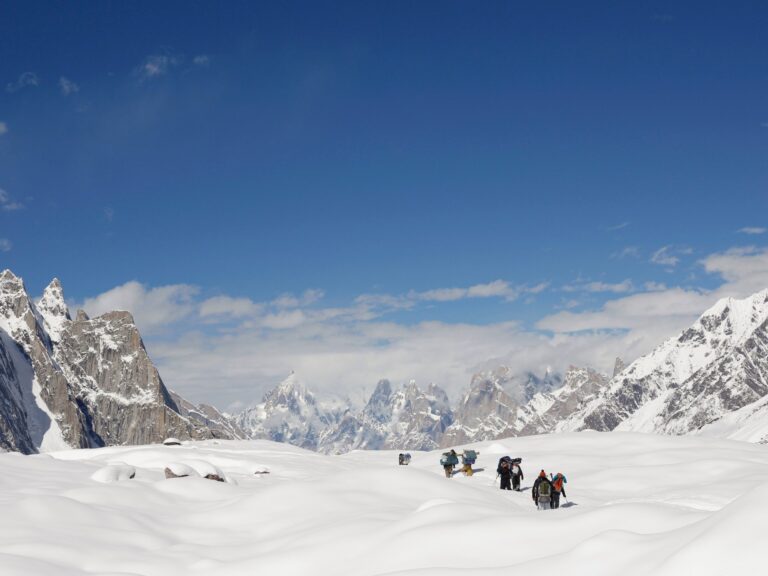“The mountain doesn’t care about anybody.”
The feat of Muhammad Ali Sadpara looms large on the landscape around Skardu. He braved the harsh conditions of the Baltoro Glacier with only second-hand equipment. Imagining the daring path he must have conquered keeps me constantly on guard for the risk of slipping, and I resist the urge to even look up or around me during the start of this arduous trek.
The organic village we trek to, locally known as Kali Nangsok, is dedicated to preserving the traditional lifestyle of the region.
A study by the World Wildlife Fund (WWF) said the region’s glaciers have been melting since the early 1900s, primarily due to “human activities” such as industrial agriculture and the burning of fossil fuels, which release carbon dioxide and other greenhouse gases into the atmosphere.
The organic and traditional farming methods adopted in the village are part of an effort aimed at reversing the rise in greenhouse gases.
In 2006, the village attracted attention when Prince Charles, then King of England, and Prince Karim Aga Khan, the spiritual leader of Ismaili Muslims, prominent philanthropist and businessman, visited it.
Our guide, Abbas, who showed us around the village, was dressed casually in blue jeans and a white shirt, and was standing next to his 16-year-old son, Yasir Abbas, wearing a backwards hat and carrying a blue backpack. Together, the two run a family tour guide business here.
With father and son leading the way with confident strides, I and my trekking companion Afzaal Hussain, 34, a digital marketing specialist, sports professional and, like me, an inquisitive traveller from Lahore, take small steps forward.
“Mountains don’t care about anyone. If you respect the mountain, it will respect you. Yes, every step has to be gentle and careful,” says Afzaal.

Along the way, we learn more about the melting glaciers. Abbas says he has witnessed the dramatic changes taking place here first-hand. He worries that the shrinking glaciers will soon lead to a sharp decline in the amount of water in the region. “Without the glaciers, without the water, our very existence would be at risk. They are the backbone of this region,” he adds.
The looming crisis in the Hindu Kush Himalayan region, which the International Centre for Integrated Mountain Development (ICIMOD) described in an independent report (PDF) last year as a vital “global asset” and “Asia’s water tower,” is already becoming apparent.
In the summer of 2023, the water level at Satpara Dam, which stores and releases water from the glacier, dropped, causing Skardu to experience a rare water shortage. “Last summer was the first time we witnessed such a severe water shortage at Satpara Dam,” Sadpara said. “This is a direct result of the melting glaciers and reduced water flow.”
Ten years earlier, in 2013, Pakistan’s Federal Minister for Science and Technology Zahid Hamid, speaking at the opening ceremony of the International Conference on Plants, Humans and Climate, warned that “by 2035, the country will have no water resources in the form of glaciers.”
And earlier, a 2008 report (PDF) from the Pakistan Meteorological Department warned that the Siachen Glacier, which stretches over 70 kilometers (43 miles) in the eastern Karakoram range of the Himalayas, had “lost about 2 kilometers in length and 17 percent of its ice mass since 1989.”

“We have seen the glaciers retreat by at least one kilometre in just a few years,” sad our guide, Abbas, who is an expert on the Siachen and Baltoro glaciers.
As well as guiding visitors to the region, he is also actively involved in research efforts and projects, aiming to educate visitors about the fragile ecosystems and environmental issues facing these majestic landscapes.
In July 2018, the Pakistani government and the United Nations Development Programme (UNDP) launched a five-year, $37 million project to invest in early warning systems, training, preparedness and response for glacial lake outburst floods (GLOFs), and building new protective infrastructure. “The project was run under my supervision in Skardu,” Abbas explains. “I served as a guide for two years, during which they worked directly on these glaciers.”

